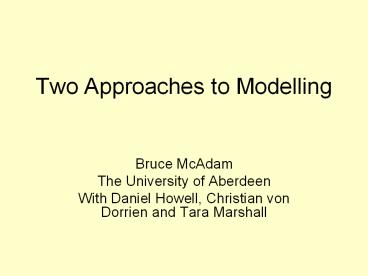Two Approaches to Modelling - PowerPoint PPT Presentation
1 / 19
Title:
Two Approaches to Modelling
Description:
... so we are starting with a simpler (Icelandic) haddock model ... Still to get assessments working for the haddock model. FLXSA. Then get it working with cod ... – PowerPoint PPT presentation
Number of Views:24
Avg rating:3.0/5.0
Title: Two Approaches to Modelling
1
Two Approaches to Modelling
- Bruce McAdam
- The University of Aberdeen
- With Daniel Howell, Christian von Dorrien and
Tara Marshall
2
UNCOVER Models
- We want to explore
- The effects of different management strategies on
fish populations - The effects of different aspects of
biology/ecology/environment on fish populations - To answer these questions we need
- Models with different degrees of realism
- Models implementing different management
strategies - We compare the outcomes of different models
3
For Example
- How will climate change affect chances of stock
recovery? - Model with two different climate scenarios
- Requires a model that depends realistically on
climate - Does improved understanding of SR relationship
affect expectations of recovery? - Model a simple SR relationship
- And a more complex one
- Compare projections.
4
Practical Matters
- We need to go from our understanding of the
fisheries - And create working models, in the form of
computer programs. - Generally we will use FLR to do this, but there
are many design decisions to make
5
Two Approaches
- Start with a simple model of biology
- Make it more complex
- This could be done in R
- This lets us compare different models of ecology
- FLR also makes adding different management
strategies easy - Start with a (preexisting) complex model
- Integrate it into FLR in order to add different
management strategies etc.
6
Examples
- You want to know whether using a more detailed SR
relation matters - start with a simple model in R (simple SR
relation, e.g. current ICES assumptions) - Make it more complex (a different SR relation,
e.g. incorporating temperature) - Compare results
- You want to compare two HCRs using the best
possible biological information - And you already have a detailed model of the
stock - Call the existing model from FLR
- Write R code for the different harvest rules and
compare results.
7
Which to Use?
- It depends on
- What question you are asking
- What prior work has been performed
- What have you already got?
- What skills are available
8
An Example
- There are Gadget models of the Barents Sea
ecosystem - These run from a stand-alone application
- They are too complex to reimplement in R
- We would like to experiment with different
environmental scenarios and management strategies - So we need to use the Gadget model from within R
9
Gadget
- Its a model that can run simulations
- Given files describing the stocks, and giving
parameters for the model - It can also be used for model fitting
- Given description of model, and observations of
the system, work out the parameters - We are using it to run simulations only
- Previous work (other projects) have done the
model fitting - It runs as a stand-along application (.exe file)
that reads and writes text files.
10
Youve seen this before
11
We use it like this
Gadget
FLR
12
Implementation
- Implement in R
- But, whenever we need a biological simulation
- Create Gadget input files
- Run the Gadget command
- Read data from Gadget output files
- This contains actual stock and catch data
- Gadget is treated as a black box
- R knows nothing about the sort of model it is.
13
Algorithm (written in R)
- Start with a folder containing all of Gadgets
input files - Run Gadget to generate output files
- Main Loop (repeat for some number of years)
- Read output files
- Create necessary FLR objects
- Run an assessment (e.g. XSA), apply a harvest
control rule (HCR) - Update Gadget input files with next years
catch/environment (and anything else needed) - Run Gadget with new input, and repeat the loop
- After finishing, plot graphs etc.
14
Preliminary Results
- The cod model is complex, so we are starting with
a simpler (Icelandic) haddock model - We model a constant recruitment scenario, with
different levels of TAC (fixed percentage of
SSB). - This is all just experimentation to check it will
be possible to implement useful models
15
Pretty Pictures
TAC10 of SSB
TAC50 of SSB
16
Technical Issues
- Weve done about 2 person-weeks of work
- We had to implement
- Reading data from Gadget
- Writing data to Gadget
- Running Gadget
- Converting Gadget data into an FLR form (FLStock
objects) - Running an assessment on the FLStocks
- Surprisingly, we found it much easier to
communicate with Gadget, than to do the
assessment in FLR (work in progress)
17
Where Next?
- Still to get assessments working for the haddock
model - FLXSA
- Then get it working with cod
- Shouldnt be too much work
- And look (a bit) at efficiency
18
Summary
- There are two different approaches to modelling
- Write a model in R, and build it up
- Start with a complex model, and call it from R
- FLR can call external models
- Its not too difficult
- You need to do quite a lot of programming in R
but not as much as implementing the model - The code you write will be case specific
- The model doesnt have to be Gadget.
19
Remember
- My job is to help people customise models like
this - But you need to keep me informed about your
objectives etc. - And make sure you use me as a resource
- Otherwise, the project will not make efficient
use of my time (I work 100 on UNCOVER).































